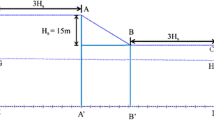Abstract
Soil hydraulic properties models which have been proposed were derived based on the empirical fitting curve such as Brooks-Corey model (BC) and Van Genuchten model (VG), or based on soil pore radius distribution such as Lognormal model (LN). Each model has different accuracy for predicting soil moisture distribution. In the analysis of rainfall-induced slope failure, the soil hydraulic properties model was needed to describe the physical phenomena of behavior characteristic of water in unsaturated soil. As moisture content has an effect on soil strength, it is vital to select the suitable soil hydraulic properties model for predicting Factor of Safety (FOS) especially in forecasting landslide hazard. In this study, a numerical model of seepage finite element analysis using BC, VG, and LN model were used and compared in order to analyze the soil moisture distribution, water movement phenomenon, and slope stability characteristic in unsaturated soil slope based on the strength reduction method (SRM). The results showed that the variations of the parameters predicting the moisture content of soil leads to differences of FOS in some cases. The parametric study showed that for the unsaturated soil condition, BC model has the greatest FOS value than the other model, while VG model has the lowest. On the other hand, the FOS of all models have the same result for the saturated condition. Other than that, it was found that the increasing of ESP value in the surface layer has significant effect in the sub-surface layer.
Similar content being viewed by others
References
Brooks, R.H. and Corey, A.T. (1964) Hydraulic properties of porous medium. In: Fort Collins (Ed.), Civil Engg. Dept., Colorado State Univ.
Bishop, A.W., Alpan, I., Blight, G.E. and Donald, I.B. (1960) Factors controlling the strength of partlys aturatedc ohesive soils. In: Conf. Shear Strength of Cohesive Soils. Proc. and Disc. ASAE, St. Joseph, MI, pp.503–532.
Chui, T.F.M. and Freyberg, D.L. (2009) Implementing hydrologic boundary conditions in a multiphysics model. Jour. Hydrologic Engg., pp.1374–1377.
COMSOL Multiphysics (2007) Earth science module User’s guide, version 3.4, COMSOL AB, Stockholm, Sweden, 142p.
Gasmo, J. M., Rahardjo, H. and Leong, E.C. (2000) Infiltration effects on stability of a residual soil slope. Jour. Computers and Geotechnics, v.26(2), pp.145–165.
Griffiths, D.V. and Lane, P.A. (1999) Slope stability analysis by finite elements. Geotechnique, v.49, pp.387–403.
Hammah, R., Yacoub, T., Corkum, B. and Curran, J. (2005) A comparison of finite element slope stability analysis with conventional limit-equilibrium investigation.
Jennings, J.E. and Burland, J.B. (1962) Limitation to use of effective stress in partlys aturated soils. Geotechnique, v.12, pp.125–144.
Kosugi, K. (1996) Lognormal distribution model for unsaturated soil hydraulic properties. Water Resources Res., v.30, pp.891–901.
Marui, H. (1981) Study on landslides at natural hill slopes. (In Japanese with English translation.) Ph.D. diss. Kyoto University, Kyoto, Japan.
Mukhlisin, M., Kosugi, K., Satofuka, Y. and Mizuyama, T. (2006) Effects of soil porosity on slope stability and debris flow runout at a weathered granitic hillslope. Vadose Zone Jour., v.5, pp.283–295.
Mukhlisin, M. and Taha, M.R. (2009) Slope stability analysis of a weathered granitic hillslope as effects of soil thickness. European Jour. Scientific Res., v.30(1), pp.36–44.
Mukhlisin, M., Baidillah M.R., Taha, M.R. and Elshafie, A. (2011a) Effect of soil water retention model on slope stability analysis. Internat. Jour. Physical Sci., v.6(19), pp.4629–4635.
Mukhlisin, M., Idris, I., Yaacob, W.Z.W., Elshafie, A. and Taha, M.R. (2011b) Soil slope deformation behavior in relation of soil water interaction based on centrifuge physical mModeling. Internat. Jour. Physical Sci., v.6(13), pp.3126–3133
Mukhlisin, M. and Taha, M.R. (2012) Numerical model of antecedent rainfall effect on slope stability at a hillslope of weathered granitic soil formation. Jour. Geol. Soc. India, v.79, pp.525–531.
Rahimi, A., Rahardjo, H. and Leong, E.-C. (2010) Effect of hydraulic properties of soil on rainfall-induced slope failure. Engg. Geol., v.114, pp.135–143.
Sammori, T. (1994) Sensitivity analyses of factors affecting landslide occurences. Tesis Ph.D. Dissertation Kyoto University, Kyoto, Japan.
Suzuki, M. (1991) Functional relationship on the critical rainfall triggering slope failures. (In Japanese with translator in English.) Jour. Japan Soc. Erosion Control Engg., v.43, pp.3–8.
van Genuchten, M.T. (1980) A closed-form equation for predicting the hydraulic conductivity of unsaturated soils. Soil Sci. Soc. Amer. Jour., v.44, pp.615–628.
Author information
Authors and Affiliations
Corresponding author
Rights and permissions
About this article
Cite this article
Mukhlisin, M., Baidillah, M.R., Ibrahim, A. et al. Effect of soil hydraulic properties model on slope stability analysis based on strength reduction method. J Geol Soc India 83, 586–594 (2014). https://doi.org/10.1007/s12594-014-0087-1
Received:
Accepted:
Published:
Issue Date:
DOI: https://doi.org/10.1007/s12594-014-0087-1




